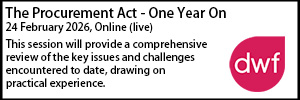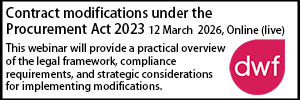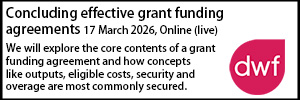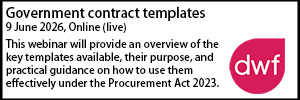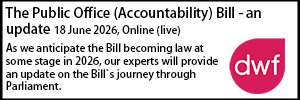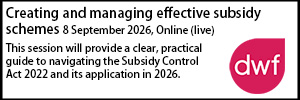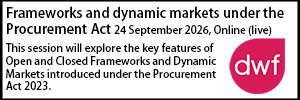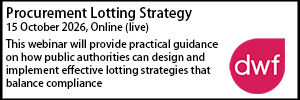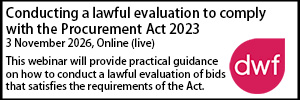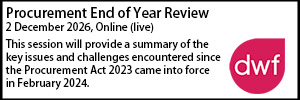Procurement Act 2023: Are you ready?
- Details
Louise Bennett sets out the key considerations for contracting authorities when they come to launch a procurement exercise under the incoming Procurement Act 2023.
With the implementation of the Procurement Act 2023 imminent, it’s important for public authorities to understand the shift in the procurement landscape and the steps needed to ensure a smooth transition to the new regime, which goes live on 24 February 2025 following a four-month delay to its initial implementation date.
Getting up to speed with new legislation can be daunting, particularly where it impacts on a business function that has such a wide reach across all departments of a public authority.
The Cabinet Office estimates the current public procurement market, which delivers services and public functions that are essential to UK infrastructure, to be worth about £300bn. Such scale highlights the importance of getting the transition to the new regime right.
The Act promises real transformation across the full lifecycle of the public procurement process, from planning through to the expiry of a contract.
But how is this achieved? In this article, we identify three key questions that authorities should consider prior to launching a procurement exercise under the new regime.
1. Are you clear which rules apply?
The first question that should be asked is: Which regime will apply?
The general concept is that any procurement commencing on or after 24 February 2025 will need to comply with the Procurement Act (see statutory guidance on Transitional and Saving Arrangements for full details).
Any procurement underway prior to 24 February will be covered by existing legislation. For a procurement to be considered “underway”, a contract notice must have been issued or a prior information notice (PIN), but only if used as a call for competition.
Authorities should be clear that commencing pre-market engagement or issuing a PIN for the purpose of pre-market engagement does not count for these purposes. That does not mean the public authority can’t use the information received in its pre-market engagement performed prior to the 24 February.
Remember that call-off arrangements from an existing framework or dynamic purchasing system (DPS) created under the Public Contract Regulations (PCR) will continue to be managed under the previous regime.
Contracts awarded prior to 24 February will continue to be managed under the existing legislation. This includes managing a modification or variation to these contracts.
Any procurement risk analysis and determination of whether it is considered a permitted modification will need to be analysed against the boundaries set out in regulation 72 of the PCR. If a modification notice is required, it must comply with regulation 72 of the PCR and not the requirements under the Act.
This demonstrates that authorities must be mindful of two regimes, even following the immediate transition period, and its governance documentation should reflect this position. If an authority has significant long-term contracts, such as waste contracts, then the PCR could stay relevant for several years.
2. Does your invitation to tender pack and contract documentation meet the requirements of the Procurement Act?
All precedent and standard documentation will need to be updated to reflect the Act, in particular to allow for the increased transparency requirements and the flexibilities afforded by the competitive flexible procedure and the ability to refine award criteria.
Drafting notes within template documents that prompt officers on how to utilise and consider these new options is an effective tool in helping promote organisational change and embracing the new regime.
All internal governance documents will need to be updated to reflect the new regime. This includes, for example, updating references to new timescales such as the new standstill period of eight working days, new procedures like the competitive flexible procedure, and new exclusion grounds.
These are just a few examples and a wholescale review of internal contract procedure rules should be undertaken so that procurement officers are clear on the steps they need to take to comply with the new regime.
3. Do you have the appropriate resources and skillset within your organisation to apply the new regime?
The drive for transparency is embedded throughout the Act and has led to an increase in notice and reporting requirements. This will inevitably put a strain on already tight resources within the public sector.
Consider whether there are areas of your team that require upskilling to allow you to comfortably meet these new demands. A great place to start is the Cabinet Office training programme and the knowledge drops that have been made available.
There may also be areas where bespoke training might be helpful. A good example of this is the ability to meet the new contract management provisions in the Act. It will be important that your team can draft effective KPIs to be reported against on an annual basis so the authority can meet new KPI obligations, which are required where a contract exceeds £5m per annum.
Another key training need may be the drafting of compliant and robust evaluation and moderation notes. If those records are lacking, it will be difficult for an authority to meet the new assessment summary requirements.
Procurement Act also brings opportunities
The introduction of the Procurement Act provides a real opportunity for the public sector to drive efficiency, innovation and value for money. To maximise benefits, each authority should familiarise itself with the Act and accompanying guidance.
If you can answer the three questions posed here positively today, then as an organisation you should be in great shape to embrace the new obligations and benefits the Act hopes to deliver.
Louise Bennett is a Senior Associate at Browne Jacobson.
Sponsored articles
Walker Morris supports Tower Hamlets Council in first known Remediation Contribution Order application issued by local authority
Unlocking legal talent
Lawyer (Planning and Regulatory)
Legal Director - Government and Public Sector
Senior Lawyer - Planning, Property & Contracts Team
Principal Lawyer - Planning, Property & Contract
Contracts Lawyer
Locums
Poll
15-07-2026 11:00 am
































